 Bleeding, dying. I seem to remember Kratos’ end being somewhat appropriate. Sure, the end of God of War 3 had some preposterous dialogue (“You fool! What have you done?”), but Kratos final line was grimly appropriate. “My vengeance ends now” he exclaimed, and he died the only way he could. By his own hand. After three games, Kratos quest for vengeance would destroy him, and in the end, the only person left to impose revenge on was himself. No one would kill Kratos. Only Kratos could kill Kratos. And it was time for him to die. How fitting. How perfect.
Bleeding, dying. I seem to remember Kratos’ end being somewhat appropriate. Sure, the end of God of War 3 had some preposterous dialogue (“You fool! What have you done?”), but Kratos final line was grimly appropriate. “My vengeance ends now” he exclaimed, and he died the only way he could. By his own hand. After three games, Kratos quest for vengeance would destroy him, and in the end, the only person left to impose revenge on was himself. No one would kill Kratos. Only Kratos could kill Kratos. And it was time for him to die. How fitting. How perfect.
So with Kratos dead and the series wrapped up with a neat little “revenge-will-be-its-own-punishment” moral, in what new direction could Santa Monica Studio take a God of War game in? Could they perhaps leave him dead, and explore a new character in the role of God of War? Certainly that’s one option I would love to have seen. But no. God of War: Ascension is a kind of prequel. Kratos is in ancient Greece in a game with with vengeance as its central motif. Initial concerns that this would be an interstitial release that added little to the series have been proven correct. God of War: Ascension’s singleplayer campaign is filler content, more akin to the PSP side stories than the main series.
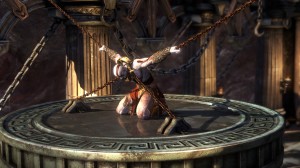 Jumping back and forward in time, the opening is inauspicious. Kratos is in chains and is being tormented by Megaera, one of the “Furies”. While I played all of the previous God of War games, my memory of Greek mythology is not great and my recollection of God of War’s fragmented narrative is worse, so I was a bit lost to begin with. It seems that this takes place after Kratos was imprisoned for breaking his oath to Ares. As the game continues, this plot jumps around a lot chronologically and you eventually start to learn a lot of little details about Kratos and his back-story.
Jumping back and forward in time, the opening is inauspicious. Kratos is in chains and is being tormented by Megaera, one of the “Furies”. While I played all of the previous God of War games, my memory of Greek mythology is not great and my recollection of God of War’s fragmented narrative is worse, so I was a bit lost to begin with. It seems that this takes place after Kratos was imprisoned for breaking his oath to Ares. As the game continues, this plot jumps around a lot chronologically and you eventually start to learn a lot of little details about Kratos and his back-story.
Still, you’re not playing as Kratos before he was given the Blades of Chaos and cursed by Ares, nor is it a different Kratos to the one you remember from all the other games. It would have been amazing to go and play as a more “human” Kratos before he fell to the barbarians – maybe one who cared about his family and had more motivations than just “kill kill kill”. Santa Monica Studios even said, “With Ascension, we can go back to a different time period before he was this character…. He has a wider range and you can explain things about him that you didn’t know before.” They fail to do anything meaningful with this though. Effectively, Kratos is the same monosyllabic character with the same motivation, the same goals and the same persona. That’s not to say that I dislike Kratos; it’s certainly cathartic to be able to cast aside contrived motivations for a protagonist and instead simply play as a guy who wants to kill everyone. It’s just that we’ve done that already. A lot. Over three games. Three games that wrapped up his story neatly.
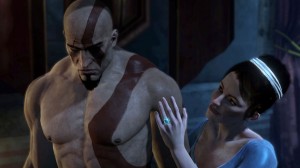 So while narratively God of War: Ascension misfires with a pointless addition to series cannon, it attempts to justify its existence through both a multiplayer mode and some small gameplay changes to the core God of War combat. While the multiplayer part is unexpectedly very good, everything else in the package is distinctly retrograde.
So while narratively God of War: Ascension misfires with a pointless addition to series cannon, it attempts to justify its existence through both a multiplayer mode and some small gameplay changes to the core God of War combat. While the multiplayer part is unexpectedly very good, everything else in the package is distinctly retrograde.
The opening is far smaller in scope and ambition than the other God of War games, at least initially. While the action does amp up as you battle against the reincarnated (and brilliantly named) Hecatonchires, the initial opening is so low key that you’ll feel like you’re playing one of the PSP spin off games. Indeed, this feeling of reduced ambition and scope is present throughout God of War: Ascension, and while an amazing sequence pops up after about half an hour with the aforementioned Hecatonchires shaking a huge building around and trying to crush it WHILE you fight inside, soon after that the whole thing calms down again significantly. Now don’t get me wrong, there is certainly spectacle in the God of War: Ascension’s set pieces that would put many other games to shame, but in comparison to the other games in the God of War series it’s all a little subdued.
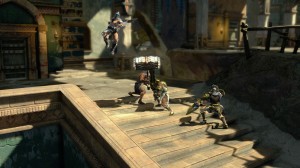 The violence and sexual content meanwhile seem to be included purely out of duty to the fans. While the death animations are still fun, they have less imagination than in the rest of the games in the series. Meanwhile, an early part of the game is absolutely full of naked women’s breasts, and generally the nudity is embarrassingly awful, completely incongruous, and representative of the very worst of immature, pitiable game character design. It’s just depressing.
The violence and sexual content meanwhile seem to be included purely out of duty to the fans. While the death animations are still fun, they have less imagination than in the rest of the games in the series. Meanwhile, an early part of the game is absolutely full of naked women’s breasts, and generally the nudity is embarrassingly awful, completely incongruous, and representative of the very worst of immature, pitiable game character design. It’s just depressing.
At an early point there is a weird tangent where a human prisoner asks for mercy from the Gods and disappears in a bright beam of light. Seemingly apropos of nothing, it turns out that this is a cross over story from the multiplayer mode. This random human prisoner who is granted mercy is in fact your avatar for when you play against other people in God of War: Ascension’s newly crafted online mode. It’s a neat touch, and if it’s a subtle nod to the player that they are spending their time playing the wrong part of God of War: Ascension then it’s very welcome. But more on that later.
 The largest problems, but also the best moments of the game, are all a result of the use of static camera angles. First, the good. The framing of some of the shots can make some of the scenes in God of War: Ascension take your breath away. Moments when you climb a ladder are always impressive, because the camera zooms out and you get to see how tiny Kratos is in comparison with whatever massive enemy is throwing buildings at him. The way that the camera pans and moves around the environment offers lots of opportunities for the developers to make the game world look gorgeous, and there’s no question that ancient Greece is a visually spectacular place to look at. More than that though, the way that the camera frames the world makes it look even more impressive. The sheer scale of the environments is what really impresses, and at one point while fighting a huge, screen-filling enemy, the cameras pans out to show you that it is, in fact, a tiny blemish on a far, far larger enemy. If Santa Monica made the action any more over the top then it would be entering Asura’s Wrath territory, and I wouldn’t be surprised to see Kratos throw Chaos Blades around the moon and drop it on an enemies head.
The largest problems, but also the best moments of the game, are all a result of the use of static camera angles. First, the good. The framing of some of the shots can make some of the scenes in God of War: Ascension take your breath away. Moments when you climb a ladder are always impressive, because the camera zooms out and you get to see how tiny Kratos is in comparison with whatever massive enemy is throwing buildings at him. The way that the camera pans and moves around the environment offers lots of opportunities for the developers to make the game world look gorgeous, and there’s no question that ancient Greece is a visually spectacular place to look at. More than that though, the way that the camera frames the world makes it look even more impressive. The sheer scale of the environments is what really impresses, and at one point while fighting a huge, screen-filling enemy, the cameras pans out to show you that it is, in fact, a tiny blemish on a far, far larger enemy. If Santa Monica made the action any more over the top then it would be entering Asura’s Wrath territory, and I wouldn’t be surprised to see Kratos throw Chaos Blades around the moon and drop it on an enemies head.
Meanwhile, the epic soundtrack is unrelentingly bombastic, and it never dials down at any point, meaning that it also never really helps heighten tension or excitement. When “epic-ness” is always set to eleven, there’s really no where for it to go to.
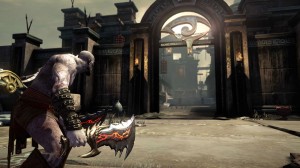 But this brings us back to by far the biggest problem in the game. It can’t frame the action in a way that lets you play it. While the other God of War games had scenes just as epic, they managed to frame that action so that you could still play, or at least separated those sequences of extreme spectacle from the combat. In God of War: Ascension, the camera will zoom out so that you are a speck of pixels (even on a 40 inch telly), and it will expect you to keep fighting a bunch of enemies who have unblockable attacks, who team up, and who have tiny prompts over their heads telling you when they can be grabbed. Prompts that you would never, ever be able to see.
But this brings us back to by far the biggest problem in the game. It can’t frame the action in a way that lets you play it. While the other God of War games had scenes just as epic, they managed to frame that action so that you could still play, or at least separated those sequences of extreme spectacle from the combat. In God of War: Ascension, the camera will zoom out so that you are a speck of pixels (even on a 40 inch telly), and it will expect you to keep fighting a bunch of enemies who have unblockable attacks, who team up, and who have tiny prompts over their heads telling you when they can be grabbed. Prompts that you would never, ever be able to see.
To some extent the game mitigates this by making Kratos stupidly hardy. Being hit by enemies takes only the tiny sliver of pixels from his health. Sure, you can up the difficulty to hard, but even there the game is never about panache or skill. Rather, it’s a slog. Too often you have no choice but to take damage, either because the enemies you face don’t have identifiable patterns of behavior, or because the camera won’t show you what is actually happening as you swing your blades wildly.
 Even here, I can imagine fans of God of War tell me that it’s not all about counters and frames of animation and combos like other similar fighting games, but is about more accessible button-mashing. If that’s the case though, why is so much of the game tailored to encourage you to avoid being hit? A prominent combo counter and moves that are only accessible when you fill that combo counter means that the game is implicitly rewarding you for avoiding taking damage. When you then take damage in a way that you couldn’t possibly avoid, you feel like the game isn’t playing fair with you.
Even here, I can imagine fans of God of War tell me that it’s not all about counters and frames of animation and combos like other similar fighting games, but is about more accessible button-mashing. If that’s the case though, why is so much of the game tailored to encourage you to avoid being hit? A prominent combo counter and moves that are only accessible when you fill that combo counter means that the game is implicitly rewarding you for avoiding taking damage. When you then take damage in a way that you couldn’t possibly avoid, you feel like the game isn’t playing fair with you.
Added to this, it’s very hard to tell when Kratos is taking damage. Going back to play God of War 1 recently, I saw how well framed the action always was, but also how the game provided visual feedback on when Kratos was taking damage. In God of War Ascension, I am always wondering why my combo counter has reset. The answer is always, “I guess I got hit and didn’t notice”. Other times, I’m only aware that Kratos is lying down because the swirly pixels of his flailing blades have stopped swirling.
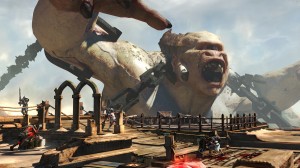 Similarly, it’s not clear what parts of boss enemies hurt you and which don’t, and as such you end up just running up to them and flailing away with your blades. Even if they have some kind of animation you are supposed to avoid, I found that it was so hard and inconsistent to try to dodge their attacks that I was better off just pummeling on the attack button till my thumb went numb.
Similarly, it’s not clear what parts of boss enemies hurt you and which don’t, and as such you end up just running up to them and flailing away with your blades. Even if they have some kind of animation you are supposed to avoid, I found that it was so hard and inconsistent to try to dodge their attacks that I was better off just pummeling on the attack button till my thumb went numb.
There is perhaps more complexity in the combat system that you could explore, but the game puts so many barriers in your way that it’s pointless to try. In the multiplayer mode the game tints characters in different colours to make their states clear (eg blocking, parrying, recovering). It might have been incongruous to see this in the singleplayer game, but it would have worked.
 For me, the final nail in the coffin for the singleplayer campaign was how you’re stripped of moves you have been accustomed to using in the other games. I know that it’s chronologically set before Kratos learned those moves, but when I was surrounded by clouds of tiny biting insects, and didn’t have an appropriate area-clearing move to deal with them like I did in the other games, my frustration levels went through the roof. Even unlocking skills and abilities seems much less impactful and meaningful than in the other God of War games, with the little blood meters in the menus looking much smaller and weedier, while the number of abilities and cool magical items you have is smaller too.
For me, the final nail in the coffin for the singleplayer campaign was how you’re stripped of moves you have been accustomed to using in the other games. I know that it’s chronologically set before Kratos learned those moves, but when I was surrounded by clouds of tiny biting insects, and didn’t have an appropriate area-clearing move to deal with them like I did in the other games, my frustration levels went through the roof. Even unlocking skills and abilities seems much less impactful and meaningful than in the other God of War games, with the little blood meters in the menus looking much smaller and weedier, while the number of abilities and cool magical items you have is smaller too.
Once you free-wheel through the campaign (or give up on it completely), the multiplayer mode offers a far more appealing prospect for gamers who are fans of both innovation and God of War. It starts intriguingly, with the same scene described earlier where Kratos meets the imprisoned human, but seen from the opposite point of view. This human is whisked away to a palace in the clouds, where you can chose to align yourself with one of four Gods, each conferring a unique class on the player. These include a kind of mage, basic fighter, a rogue-like and a support class, under the tutelage of Zeus, Ares, Hades and Poseidon respectively. Even the visuals of the multiplayer tutorial seemed better to than the main campaign, and it’s like most of the effort and thought has been put into this part of the game. As I customized my avatar in the limited-but-fun character editor, I imagined how great it would be if I could take this guy into the singleplayer game and use him instead of Kratos. I had done relatively little with him, choosing a race and some armour and a spear as a weapon, but already I felt more excited and engaged in his presence than I did when I was controlling the “Ghost of Sparta”.
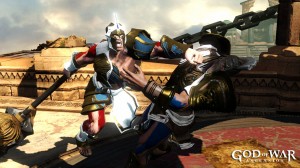 Although the cosmetic customisation is much more limited than I would like to see, there’s a fair amount of RPG underpinnings to the process of designing your character. As well as your allegiance to a God (which determines your class) you can also choose different armour and weapons. Armours can confer elemental resistances as well as extend your health bar, and the different weapons will completely change how your character fights. The game wants you to play a lot to unlock more advanced weapons and armour though, as well as a myriad other types of power-ups, so I advise getting into the multiplayer mode early while everyone is still learning its systems. At the moment no one really exploits all the games complex mechanics, but if you come to this in a few months time when everyone has the gameplay down and has unlocked powerful weapons and armour, I think it could be a very off-putting experience. Best to skip the lackluster singleplayer campaign and start learning how to play this mode early.
Although the cosmetic customisation is much more limited than I would like to see, there’s a fair amount of RPG underpinnings to the process of designing your character. As well as your allegiance to a God (which determines your class) you can also choose different armour and weapons. Armours can confer elemental resistances as well as extend your health bar, and the different weapons will completely change how your character fights. The game wants you to play a lot to unlock more advanced weapons and armour though, as well as a myriad other types of power-ups, so I advise getting into the multiplayer mode early while everyone is still learning its systems. At the moment no one really exploits all the games complex mechanics, but if you come to this in a few months time when everyone has the gameplay down and has unlocked powerful weapons and armour, I think it could be a very off-putting experience. Best to skip the lackluster singleplayer campaign and start learning how to play this mode early.
Once you get into the multiplayer, it really is unlike anything you’ll have played before. The most common game mode is a kind of team-based combat, and it takes place in complex environments with collapsing platforms, environmental hazards and all sorts of other cool dynamic effects. The environments are all based on locales from throughout the series, and it’s a bit like a 3D Smash Brothers. Its great to see lots of little incidental details in the background, and characters like Achilles and the Gods make frequent cameos.
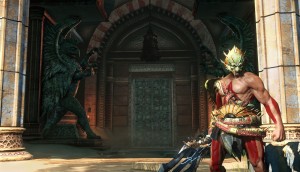 The comprehensive tutorial system teaches you the games combat system, and it’s good that the tutorial is well designed. This is a complex game, and there’s absolutely nothing else like it. It has a rock-paper-scissors approach, with light attacks pre-empting heavy ones, heavy attacks smashing through blocks or parries and parries deflecting light attacks. There are also grabs and melee attacks included too, and when you combine this with special attacks, magic attacks, a rage meter, weapons you can pick up, customisable load outs and brutal finishers, you have a game that will take a long time to learn and longer to master.
The comprehensive tutorial system teaches you the games combat system, and it’s good that the tutorial is well designed. This is a complex game, and there’s absolutely nothing else like it. It has a rock-paper-scissors approach, with light attacks pre-empting heavy ones, heavy attacks smashing through blocks or parries and parries deflecting light attacks. There are also grabs and melee attacks included too, and when you combine this with special attacks, magic attacks, a rage meter, weapons you can pick up, customisable load outs and brutal finishers, you have a game that will take a long time to learn and longer to master.
The most exciting thing of all about the mutliplayer part of God of War is that it doesn’t play like the singleplayer game. In fact, it doesn’t play like anything I’ve seen. While the singeplayer game feels like it can be completed by face-rolling the controller buttons, the multiplayer is very cerebral and tactical. It’s all about psyching your opponent out to commit to an attack, then punishing them mercilessly. Although at first it seems chaotic and messy and offensive, you will find yourself losing over and over again to better players until you learn to counter, block and observe the little cues in their animation that tell you what they will do. It’s too early to tell if it will really find an audience or if the combat system is really deep and balanced, but early signs are very good. Hopefully, early connection problems I experienced will also be addressed, and to be fair they did seem to be getting less frequent as I played more.
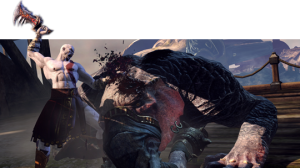 God of War: Ascension is a game of two half’s. One is pure filler: enjoyable only in the most limited of ways. The singleplayer campaign, although competent and at times visually impressive, is embarrassingly backwards gameplay-wise, and especially when compared with brilliant and original hack and slash games like Revengeance and DmC, looks sadly out of touch with modern gaming. The multiplayer meanwhile is a complete oddity, but a brilliant one. Original, deep and satisfying with intriguing customisation options, it shows that Santa Monica Studios are not out of steam yet, even if Kratos is.
God of War: Ascension is a game of two half’s. One is pure filler: enjoyable only in the most limited of ways. The singleplayer campaign, although competent and at times visually impressive, is embarrassingly backwards gameplay-wise, and especially when compared with brilliant and original hack and slash games like Revengeance and DmC, looks sadly out of touch with modern gaming. The multiplayer meanwhile is a complete oddity, but a brilliant one. Original, deep and satisfying with intriguing customisation options, it shows that Santa Monica Studios are not out of steam yet, even if Kratos is.
7 God’s of Snore/God’s of Whoa! out of 10
